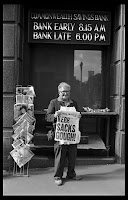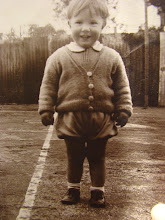 |
| "The Kiss, Bourke Street, 1978" Rennie Ellis Photographic Archive |
 |
| Photograph: Robert McFarlane |
Issues facing photographers who work in the public domain (pictured) - creating visual histories of our times (such as Melbourne's remarkable diarist, the late Rennie Ellis (1940-2003)http://www.rennieellis.com.au/ ) are not going away. (Distinguished photojournalist Michael Coyne explores this issue further on in this blog) Now, in the spirit of open debate ARENA magazine http://www.arena.org.au/ will host a discussion at their Project Space, 2 Kerr Street, Fitzroy, Melbourne, chaired by Melissa Miles, on Tuesday, August 16th, at 6 p.m. In a recent issue of ARENA Miles, together with Jessica Whyte, made this timely, acute observation: "In recent years everything from terrorism to paedophilia has been used to rationalise the restriction of photography in public while the social changes and anxieties that inform the restrictions, such as shifts between the public and the private, are obscured. Photography is uniquely suited to showing us un-encountered aspects of public life, and its power to make visible is central to the ways we structure, negotiate and experience the public and the private." Miles, a lecturer in Art, Design and Architecture at Monash University, will talk about this area of vital concern and Monash University's "Photography as a Crime" project. For further details, phone 03 9416 0232 or 0437 960 510 or go to ARENA magazine's website. http://www.arena.org.au/
STANDING YOUR GROUND, ON THE STREET
Just received this link from Hong Hong documentary photographer Bob Davis http://www.bobdavis-photographer.com/ ("Faces of Japan" 1978 Kodansha International) via Robin Moyer http://www.robinmoyer.com/portfolio.html about a fascinating exercise carried out recently by six photographers acting on behalf of the London Street Photographers Festival. All were assigned to photograph, on the street, in public, in different parts of London as part of a LSPF project "STAND YOUR GROUND". Their filmed reactions, and those of police and officials, perfectly express the dilemmas faced by photographers working in public spaces today, worldwide. Caused partly by the paranoia created by recent terrorist acts in London, there was general confusion about what rights photographers have to document what is before their cameras. The London police, oddly, come out as the most reasonable of inquisitors into the world of photographing on the street - having, after all, to enforce the law - which clearly still allows the taking of photographs in public in Britain. Full details of this are included in the clip.
The Phenomenology of The FaceSTANDING YOUR GROUND, ON THE STREET
Just received this link from Hong Hong documentary photographer Bob Davis http://www.bobdavis-photographer.com/ ("Faces of Japan" 1978 Kodansha International) via Robin Moyer http://www.robinmoyer.com/portfolio.html about a fascinating exercise carried out recently by six photographers acting on behalf of the London Street Photographers Festival. All were assigned to photograph, on the street, in public, in different parts of London as part of a LSPF project "STAND YOUR GROUND". Their filmed reactions, and those of police and officials, perfectly express the dilemmas faced by photographers working in public spaces today, worldwide. Caused partly by the paranoia created by recent terrorist acts in London, there was general confusion about what rights photographers have to document what is before their cameras. The London police, oddly, come out as the most reasonable of inquisitors into the world of photographing on the street - having, after all, to enforce the law - which clearly still allows the taking of photographs in public in Britain. Full details of this are included in the clip.
Actor and Photographer Stuart Campbell (1951-2009) spent most of his life making faces - either as one of Australia's finest character actors, or in his less well known role as a photographer. Campbell never paraded his talent with the camera but his "eye" was highly sought after by fellow actors and 'showfolk'. Just how much delight Campbell took in the portrayal of his peers is currently on show at the mezzanine level of the Wharf Theatre of the Sydney Theatre Company. http://www.sydneytheatre.com.au/ Recently seen on exhibi
 tion at Canberra's National Portrait Gallery, where one of his subjects, author and friend Lee Tulloch, commented "Stuart Campbell’s gifts as a photographer were many but what made him unique was his ability to disarm his subjects with outlandish wit, shocking them out of their self-consciousness so that they revealed more of themselves than they had ever intended."
tion at Canberra's National Portrait Gallery, where one of his subjects, author and friend Lee Tulloch, commented "Stuart Campbell’s gifts as a photographer were many but what made him unique was his ability to disarm his subjects with outlandish wit, shocking them out of their self-consciousness so that they revealed more of themselves than they had ever intended." Campbell had the simplest of photographic techniques - lighting that gave each sitter's face a luminousity and compositions that gave sculptural form to each person's body language. It is hard to escape the view that his portraits became essentially a vibrant dialogue, with each sitter eventually offering up the most intimate aspects of their personalities to Campbell's camera. This photographer was also clearly a devotee of classic black and white analog photography, reinforced by rich, traditional darkroom printing. Campbell was equally at home photographing men or women, whether the manic King Lear like antics of celebrated stage actor Ron Hadd
Campbell had the simplest of photographic techniques - lighting that gave each sitter's face a luminousity and compositions that gave sculptural form to each person's body language. It is hard to escape the view that his portraits became essentially a vibrant dialogue, with each sitter eventually offering up the most intimate aspects of their personalities to Campbell's camera. This photographer was also clearly a devotee of classic black and white analog photography, reinforced by rich, traditional darkroom printing. Campbell was equally at home photographing men or women, whether the manic King Lear like antics of celebrated stage actor Ron Hadd rick,(pictured, above left) the unmistakable, defined
rick,(pictured, above left) the unmistakable, defined  planes of Belinda Giblin's face (pictured, left) or the stillness he captured in Wendy Hughes' extraordinary face, early in her career.(pictured, above left) One of his most memorable images is of legendary Australian performer, Little Nell, pressed against the rough texture of a wall.(pictured, right) This unforgettable picture, with its partial nudity, is as hard to categorise, and as unforgettable, as Little Nell herself. Campbell's working life also paralleled that of Mel Gibson's Australian career, and we see an impossibly young Gibson in an early Campbell photograph.(pictured, above right) I first heard of this exhibition through a call received from film director Gillian Armstrong, a close friend of Campbell. After Campbell's death in 2009, Armstrong was instrumental in presenting his archive to the National Portrait Gallery. http://www.portrait.gov.au/site/exhibition_subsite_stuartcampbell.php?pagenum= Considering that Campbell had photographed many of the key figures in the renaissance of Australian film and theatre from the 1970's onwards, they were delighted to offer an exhibition, "Between Light and Shadow", which only finished in July. A spokesperson for Sydney Theatre Company said there is no closing date planned for the Stuart Campbell exhibition, at this stage. On display on the Mezzanine at the Wharf Theatre, Pier 4-5, Hickson Road, Walsh Bay, Sydney.
planes of Belinda Giblin's face (pictured, left) or the stillness he captured in Wendy Hughes' extraordinary face, early in her career.(pictured, above left) One of his most memorable images is of legendary Australian performer, Little Nell, pressed against the rough texture of a wall.(pictured, right) This unforgettable picture, with its partial nudity, is as hard to categorise, and as unforgettable, as Little Nell herself. Campbell's working life also paralleled that of Mel Gibson's Australian career, and we see an impossibly young Gibson in an early Campbell photograph.(pictured, above right) I first heard of this exhibition through a call received from film director Gillian Armstrong, a close friend of Campbell. After Campbell's death in 2009, Armstrong was instrumental in presenting his archive to the National Portrait Gallery. http://www.portrait.gov.au/site/exhibition_subsite_stuartcampbell.php?pagenum= Considering that Campbell had photographed many of the key figures in the renaissance of Australian film and theatre from the 1970's onwards, they were delighted to offer an exhibition, "Between Light and Shadow", which only finished in July. A spokesperson for Sydney Theatre Company said there is no closing date planned for the Stuart Campbell exhibition, at this stage. On display on the Mezzanine at the Wharf Theatre, Pier 4-5, Hickson Road, Walsh Bay, Sydney. POST SCRIPT:
I last saw Stuart Campbell (pictured right, in a self portrait) while I was working as a stills photographer on the set of the 1996 film "Dating The Enemy", which starred Claudia Karvan and Guy Pearce. Stuart Campbell had a small role playing, ironically, a photographer pursuing Guy Pearce's television celebrity character, in the intrusive style of the Paparazzi. While the director, Megan Simpson Huberman, was preparing for the scene in which Campbell would secretly photograph Pearce in Sydney's Hyde Park, Pearce wandered up to Campbell as he was busily assembling his impressive camera outfit, adding a very long, expensive looking, fast lens, for the scene to come. Idly making conversation, Pearce asked Campbell whether the camera and lens belonged to him. "No," answered Campbell, a little shortly, "they were supplied by the film's producers." Looking at the impressive array of lens and camera, Pearce casually continued, "bet you wish you could take them home." Campbell, who never made a secret of his gay sexuality, looked up at Pearce and replied, "No, but I wish I could take you home." The conversation abruptly ended there and Pearce moved away to diligently prepare for his next scene.
JESSE MARLOW TOPS "LONDON STREET PHOTOGRAPHY FESTIVAL"
  |
| Jesse Marlow L and Hannah White, R, the Event's Coordinator |
HENRI CARTIER-BRESSON IS COMING TO BRISBANE.
Coincidentally, photographs by arguably the greatest street photographer of them all, Henri Cartier-Bresson, will soon be seen in Brisbane with the mammoth exhibition, "The Man, The Image & The World" http://qag.qld.gov.au/exhibitions/coming_soon/henri_cartier-bresson opening on August 27 at the Queensland Art Gallery. On exhibition for three months, this extraordinary display shows how Henri Cartier-Bresson (1908-2004) charted the currents of artistic, cultural and political change within the 20th Century and promises to be the most expansive display of the great photographer's work yet seen in this country. Combined with QAG's other shows of Surrealism and Matisse, a journey to Brisbane would seem to be essential within the near future.
Text Copyright 2011 by Robert McFarlane www.robertmcfarlanephotos.com



No comments:
Post a Comment